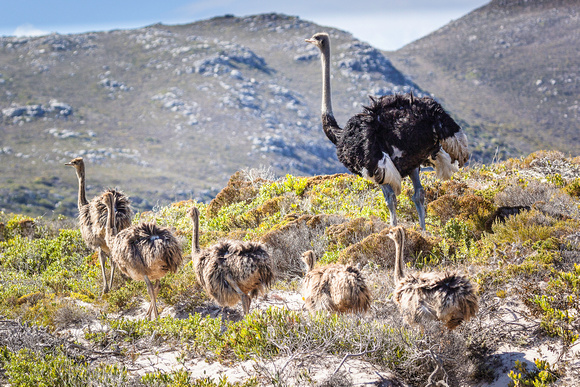Male Ostrich and chicks
Ostrich (Struthio camelus)
Up to 6 feet tall
Ostriches formerly occupied Africa north and south of the Sahara, East Africa, Africa south of the rain forest belt, and much of Asia Minor. Today ostriches prefer open land and are native to the savannas and Sahel of Africa, both north and south of the equatorial forest zone. In Southwest Africa they inhabit the semi-desert or true desert. They rarely go above 100 m (330 ft). Farmed ostriches in Australia have established feral populations. The Arabian ostriches in the Near and Middle East were hunted to extinction by the middle of the 20th century. Ostriches have occasionally been seen inhabiting islands on the Dahlak Archipelago, in the Red Sea near Eritrea. Common in the drier areas.
Ostriches live in nomadic groups of 5 to 50 birds.
The ostrich's diet consists mainly of plant matter (succulents and other plants, berries and seeds), though it also occasionally eats insects such as locusts. Lacking teeth, they swallow pebbles that act as gastroliths to grind food in the gizzard.
Ostriches can go without drinking for several days, using metabolic water and moisture in ingested plants, but they enjoy liquid water and frequently take baths where it is available. They can survive losing up to 25% of their body weight through dehydration.
When threatened, the ostrich will either hide itself by lying flat against the ground, or run away. If cornered, it can attack with a kick of its powerful legs. Mating patterns differ by geographical region, but territorial males fight for a harem of two to seven females.
The nest is a hollow scrape in the ground, constructed by the male. A single communal nest is used for the eggs. The dominant female will lay her eggs first and when it comes to incubate the eggs will discard extra eggs from the weaker females, leaving about 20 in the nest. A female ostrich can distinguish her own eggs from the others in a communal nest. Usually the black and white male incubates the eggs at night and the inconspicuous brown female incubates the eggs during the day, but this is not a hard and fast rule. Typically, the male defends the hatchlings and teaches them to feed, although males and females cooperate in rearing chicks. Fewer than 10% of nests survive the 9 week period of laying and incubation, and of the surviving chicks, only 15% of those survive to 1 year of age. However, among those ostriches who survive to adulthood, the species is one of the longest-living bird species. Ostriches in captivity have lived to 62 years and 7 months.
Common predators of nests and young ostriches include jackals, various birds of prey, warthogs, mongoose and vultures. If the nest or young are threatened, either or both of the parents may create a distraction, feigning injury. However, they may sometimes fiercely fight predators, especially when chicks are being defended, and have been capable of killing even their largest enemies, the lions, in such confrontations.
The ostrich is farmed around the world, particularly for its feathers, which are decorative and are also used as feather dusters. Its skin is used for leather products and its meat is marketed commercially.
Photographed at Table Mountain National Park, Cape Point, South Africa.


